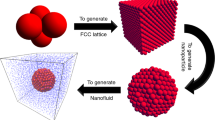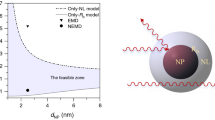Abstract
The effect of the molecular layering at liquid–solid interface on the thermal conductivity of the nanofluid is investigated by an equilibrium molecular dynamics simulation. By tracking the position of the nanoparticle and the liquid atoms around the spherical nanoparticle, it was found that a thin layer of liquid is formed at the interface between the nanoparticle and liquid; this thin layer will move with the Brownian motion of the nanoparticle. Through the analysis of the density distribution of the liquid near the nanoparticle, it is found that more argon atoms are attracted to form the layer around the nanoparticle when the diameter of the nanoparticle is larger, and therefore lead to the more significant enhancement of the thermal conductivity of the nanofluid.









Similar content being viewed by others
Abbreviations
- E :
-
Excess energy
- h :
-
Mean partial enthalpy
- I :
-
Unit vector
- Jq(0):
-
Heat current vector at time zero
- Jq(t):
-
Heat current vector at time t
- k :
-
Thermal conductivity of nanofluids
- k B :
-
Boltzmann constant
- m :
-
Mass or number of time steps
- M :
-
Total number of MD time steps for averaging
- n :
-
Number of time steps or number density
- N :
-
Number of atoms or total number of MD simulation time steps
- r :
-
Position vector
- r ij :
-
Distance between atoms i and j
- t :
-
Time
- T :
-
Temperature
- v :
-
Velocity
- V :
-
Volume
- Δt :
-
Time step
- ϕ:
-
Volume fraction of nanoparticles
- Φ:
-
Lennard Jones potential
- σ:
-
Lennard Jones distance parameter
- ε:
-
Lennard Jones cohesive energy parameter
- ρ:
-
Density
- s:
-
Solid
- l:
-
Liquid
- α, β:
-
Copper or argon
References
Allen MP, Tildesley DJ (1987) Computer simulations of liquids. Clarendon, Oxford
Assael MJ, Chen C-F, Metaxa I, Wakeham WA (2004) Thermal conductivity of suspensions of carbon nanotubes in water. Int J Thermophys 25:971–985
Das SK, Putra N, Thiesen P, Roetzel W (2003) Temperature dependence of thermal conductivity enhancement for nanofluids. ASME J Heat Transf 125:567–574
Das SK, Choi SUS, Patel HE (2006) Heat transfer in nanofluids—a review. Heat Transf Eng 27:3–9
Eapen J, Li J, Yip S (2002) Mechanism of thermal transport in dilute nanocolloids. Phys Rev Lett 98:028302
Evans W, Fish J, Keblinski P (2006) Role of Brownian motion hydrodynamics on nanofluid thermal conductivity. Appl Phys Lett 88:093116
Jang SP, Choi SUS (2006) Role of Brownian motion in the enhanced thermal conductivity of nanofluids. Appl Phys Lett 84:4316–4318
Keblinksi P, Phillpot SR, Choi SUS, Eastman JA (2002) Mechanisms of heat flow in suspensions of nano-sized particles (nanofluids). Int J Heat Mass Transf 45:855–863
Koo J, Kleinstreuer C (2004) A new thermal conductivity model for nanofluids. J Nanopart Res 6:577–588
Leong KC, Yang C, Murshed SMS (2006) A model for the thermal conductivity of nanofluids—the effect of interfacial layer. J Nanopart Res 8:245–254
Poulikakos D, Arcidiacono S, Maruyama S (2003) Molecular dynamics simulations in nanoscale heat transfer: a review. Microscale Thermophys Eng 7:181–206
Prasher R, Bhattacharya P, Phelan PE (2005) Thermal conductivity of nanoscale colloidal solutions (nanofluids). Phys Rev Lett 94:025901
Prasher R, Bhattacharya P, Phelan PE (2006) Brownian-motion-based convective-conductive model for the effective thermal conductivity of nanofluids. J Heat Transf 128:588–595
Rapaport DC (2001) The art of molecular dynamics simulation. Cambridge University Press, Cambridge
Sarkar S, Selvam RP (2007) Molecular dynamics simulation of effective thermal conductivity and study of enhanced thermal transport mechanism in nanofluids. J Appl Phys 102:074302
Tretiakov KV, Scandolo S (2004) Thermal conductivity of solid argon from molecular dynamics simulations. J Chem Phys 120:3765–3769
Vogelsang R, Hoheisel C, Ciccotti G (1987) Thermal conductivity of the Lennard-Jones liquid by molecular dynamics calculations. J Chem Phys 86:6371–6375
Xie H, Wang J, Xi T, Liu Y, Ai F, Wu Q (2002) Thermal conductivity enhancement of suspensions containing alumina particles. J Appl Phys 91:4568–4572
Xie H, Fujii M, Zhang X (2005) Effect of interfacial nanolayer on the effective thermal conductivity of nanoparticle-fluid mixture. Int J Heat Mass Transf 48:2926–2932
Xue L, Keblinski P, Phillpot SR, Choi SUS, Eastman JA (2004) Effect of liquid layering at the liquid-solid interface on thermal transport. Int J Heat Mass Transf 47:4277–4284
Yu W, Choi SUS (2003) The role of interfacial layers in the enhanced thermal conductivity of nanofluids: a renovated Maxwell model. J Nanopart Res 5:167–171
Yu CJ, Richter AG, Datta A, Durbin MK, Dutta P (2000) Molecular layering in a liquid on a substrate: an X-ray reflective study. Physica B 283:27–31
Acknowledgments
This study was funded by the Office of Naval Research Grant No. N00014-06-1-1119. Ling Li and Mo Yang also acknowledge the supports received from the Key Discipline Construction Foundation of Shanghai Municipality under Grant No. J50501, the Key Project program of the National Natural Science Fund of China under Grant No. 50636050, and the Natural Science Fund of Shanghai under Grant No. 09ZR1422400.
Author information
Authors and Affiliations
Corresponding author
Additional information
This work was completed at University of Missouri during the first author’s visiting appointment.
Rights and permissions
About this article
Cite this article
Li, L., Zhang, Y., Ma, H. et al. Molecular dynamics simulation of effect of liquid layering around the nanoparticle on the enhanced thermal conductivity of nanofluids. J Nanopart Res 12, 811–821 (2010). https://doi.org/10.1007/s11051-009-9728-5
Received:
Accepted:
Published:
Issue Date:
DOI: https://doi.org/10.1007/s11051-009-9728-5




